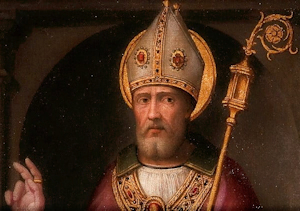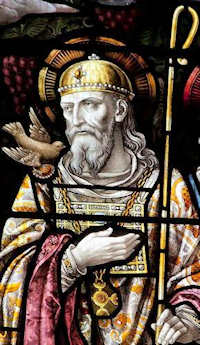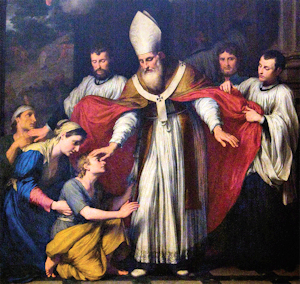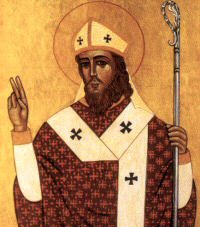Ordinary Time: January 13th
Friday of the First Week in Ordinary Time; Optional Memorial of St. Hilary of Poitiers, Bishop and Doctor
Other Commemorations: St. Kentigern, Bishop (RM; Scotland, Memorial); St. Remigius, Bishop (RM)
» Enjoy our Liturgical Seasons series of e-books!
St. Hilary of Poitiers (310-367) was one of the great champions of the Catholic belief in the divinity of Christ. By his preaching, his treatise on the Trinity, his part in the Councils, his daring opposition to the Emperor Constantius, he showed himself a courageous apostle of the truth. He could not tolerate that the specious plea of safeguarding peace and unity should be allowed to dim the light of Gospel teaching. Bl. Pius IX proclaimed him a doctor of the Church.
St. Kentigern, Monk (518-603), is celebrated as a Memorial today in Scotland. He was a missionary to Scotland and bishop of the Strathclyde Britons. Exiled, he fled to Wales. He died in 603.
The Roman Martyrology also commemorates St. Remigius, Bishop and Confessor (438-533). He baptized King Clovis, bringing the Frankish nation to Christianity. He is one of the patrons of France.
St. Hilary of Poitiers
St. Hilary was one of those great Christian heroes who poured out their lives laboring and suffering in defense of Christ's divinity. Scarcely had the days of bloody persecution ended (313), when there arose, now within the Church, a most dangerous enemy of another sort, Arianism. The heresy of Arianism denied the divinity of Christ; it was, in fact, hardly more than a form of paganism masquerading as the Christian Gospel. The smoldering strife soon flared into a mighty conflict endangering the whole Church; and its spread was all the more rapid and powerful because emperors, who called themselves Christian, proved its best supporters. Once again countless martyrs sealed in blood their belief in Christ's divinity; and orthodox bishops who voiced opposition were forced into exile amid extreme privations.
 Among the foremost defenders of the true faith stood Hilary. He belonged to a distinguished family and had received an excellent education. Though a married man, he was made bishop of Poitiers by reason of his exemplary life. It was not long before his valiant defense of the faith precipitated his exile to Phrygia. Here he composed his great work on the Blessed Trinity (in twelve books). It is a vigorous defense of the faith, which, he said, "triumphs when attacked." Finally, after four years he was permitted to return to his native land. He continued his efforts, and through prudence and mildness succeeded in ridding Gaul of Arianism. Because of his edifying and illustrious writings on behalf of the true religion, the Church honors him as one of her doctors.
Among the foremost defenders of the true faith stood Hilary. He belonged to a distinguished family and had received an excellent education. Though a married man, he was made bishop of Poitiers by reason of his exemplary life. It was not long before his valiant defense of the faith precipitated his exile to Phrygia. Here he composed his great work on the Blessed Trinity (in twelve books). It is a vigorous defense of the faith, which, he said, "triumphs when attacked." Finally, after four years he was permitted to return to his native land. He continued his efforts, and through prudence and mildness succeeded in ridding Gaul of Arianism. Because of his edifying and illustrious writings on behalf of the true religion, the Church honors him as one of her doctors.
Here is an example of Hilary's vigorous style: "Now it is time to speak, the time for silence is past. We must expect Christ's return, for the reign of Antichrist has begun. The shepherds must give the warning signals because the hirelings have fled. Let us lay down our lives for the sheep, for brigands have entered the fold and the roaring lion is rampaging about. Be ready for martyrdom! Satan himself is clothed as an angel of light." A favorite motto of St. Hilary was Ministros veritatis decet vera proferre, "Servants of the truth ought speak the truth."
—From Pius Parsch, The Church's Year of Grace, Pius Parsch
Patronage: Against snakes; against snake bites; against rheumatism; children learning to walk; mothers; sick people; La Rochelle, France; Poitiers Luçon, France; Argusto, Italy; Parma, Italy; Vervio, Italy
Symbols and Representation: dragon; serpent; stick; pen; child; episcopal vestments, a mitre and crozier, and a beard, usually white and often longHighlights and Things To Do:
- Read more about St. Hilary:
- See the library of St. Hilary's writings.
- St. Hilary's tomb was originally located in L’Eglise Saint-Hilaire-le-Grand (Church of St. Hilary the Great). According to Saints in Rome and Beyond!, "In 1572 this tomb was plundered by French Huguenots and St Hilary’s relics lost. Nearly a century later in 1657 a miraculous discovery of his relics was claimed in Le Puy, France. These relics were then transferred to Poitiers some years later. Today they are located within an ornate bronze reliquary in the crypt of this church."
St. Kentigern
 St. Kentigern was also known as Mungo ("dear one" or "darling"), his mother was a British princess named Thenaw (or Thaney or Theneva). When it was discovered that she was pregnant of an unknown man, she was hurled from a cliff and, when discovered alive at the foot of the cliff, was set adrift in a boat on the Firth of Forth. She reached Culross, was given shelter by St. Serf, and gave birth to a child to whom Serf gave the name Mungo. Raised by the saint, he became a hermit at Glasgow and was so renowned for his holiness that he was consecrated bishop of Strathclyde about 540. Driven to flight because of the feuds among the neighboring chieftains, he went to Wales, met St. David at Menevia, and founded a monastery at Llanelwy. About 553, Kentigern returned to Scotland, settled at Hoddam, and then returned to Glasgow, where he spent his last days. He is considered the first bishop of Scotland and with Thenaw is joint patron of Glasgow.
St. Kentigern was also known as Mungo ("dear one" or "darling"), his mother was a British princess named Thenaw (or Thaney or Theneva). When it was discovered that she was pregnant of an unknown man, she was hurled from a cliff and, when discovered alive at the foot of the cliff, was set adrift in a boat on the Firth of Forth. She reached Culross, was given shelter by St. Serf, and gave birth to a child to whom Serf gave the name Mungo. Raised by the saint, he became a hermit at Glasgow and was so renowned for his holiness that he was consecrated bishop of Strathclyde about 540. Driven to flight because of the feuds among the neighboring chieftains, he went to Wales, met St. David at Menevia, and founded a monastery at Llanelwy. About 553, Kentigern returned to Scotland, settled at Hoddam, and then returned to Glasgow, where he spent his last days. He is considered the first bishop of Scotland and with Thenaw is joint patron of Glasgow.
—From John J. Delaney, Dictionary of Saints
Patronage: salmon; Carlisle, England; Glasgow, Scotland; archdiocese of Liverpool, England; St Asaph, Wales
Symbols and Representation: Bell; bird; clock; fish; ring; robin; salmon; tree
Highlights and Things to Do:
- Make a custard pie in honor of St. Kentigern.
- St. Kentigern's relics are in the relics in the crypt of the Kentigern Cathedral, Glasgow. See more Images of the cathedral.
- Read more about St. Kentigern:
- Why Glasgow celebrates St Mungo's Day.
- Read about the History of St. Mungo.
St. Remigius
 Also known as Remi, he was born at Laon, the son of Count Emilius of Laon and St. Celina. He became known for his preaching, and in 459, when he was only twenty-two, he was appointed bishop of Rheims. He was ordained and consecrated and reigned for more than seventy years, devoting himself to the evangelization of the Franks. In 496, Clovis, pagan King of northern Gaul, supposedly in response to a suggestion by his wife, Clotildis, a Christian, invoked the Christian God when the invading Alemanni were on the verge of defeating his forces, whereupon the tide of battle turned and Clovis was victorious. St. Remigius, aided by St. Vedast, instructed him and his chieftains in Christianity, and soon after baptized Clovis, his two sisters, and three thousand of his followers. Remigius was a zealous proponent of orthodoxy, opposed Arianism, and converted an Arian bishop at a synod of Arian bishops in 517. He was censured by a group of bishops for ordaining one Claudius, whom they felt was unworthy of the priesthood, but St. Remigius was generally held in great veneration for his holiness, learning, and miracles. He was the most influential prelate of Gaul and is considered the apostle of the Franks. He died at Rheims on January 13.
Also known as Remi, he was born at Laon, the son of Count Emilius of Laon and St. Celina. He became known for his preaching, and in 459, when he was only twenty-two, he was appointed bishop of Rheims. He was ordained and consecrated and reigned for more than seventy years, devoting himself to the evangelization of the Franks. In 496, Clovis, pagan King of northern Gaul, supposedly in response to a suggestion by his wife, Clotildis, a Christian, invoked the Christian God when the invading Alemanni were on the verge of defeating his forces, whereupon the tide of battle turned and Clovis was victorious. St. Remigius, aided by St. Vedast, instructed him and his chieftains in Christianity, and soon after baptized Clovis, his two sisters, and three thousand of his followers. Remigius was a zealous proponent of orthodoxy, opposed Arianism, and converted an Arian bishop at a synod of Arian bishops in 517. He was censured by a group of bishops for ordaining one Claudius, whom they felt was unworthy of the priesthood, but St. Remigius was generally held in great veneration for his holiness, learning, and miracles. He was the most influential prelate of Gaul and is considered the apostle of the Franks. He died at Rheims on January 13.
—Dictionary of Saints, John J. Delaney
Patronage: France
Symbols and Representation: Oil stock; dove with Holy Ampulla in its beak; birds; veil of St. Veronica; font; broken fetters.
Often Portrayed As: Dressed as a bishop with a miter and staff with a cross and is holding the oil of the sacred phial in his right hand with a dove hovering over. For centuries the events at the crowning of Clovis I became a symbol used by the monarchy to claim the divine right to rule.
Highlights and Things to Do:
- Read more about St. Remigus:
- Learn about Rheims, France and the Cathedral of Our Lady of Rheims where King Clovis was baptized.
- Find out what the divine right of kings means.
- His relics are located in the Basilica of Saint-Remi (Basilica of Rheims, France).
- See the statue of St. Remigius on St. Peter's Basilica Colonnade.
- Read Pope John Paul's Apostolic Exhortation, Ecclesia in Europa.






